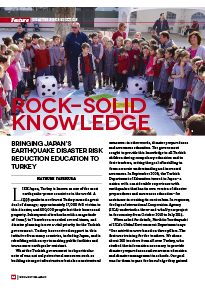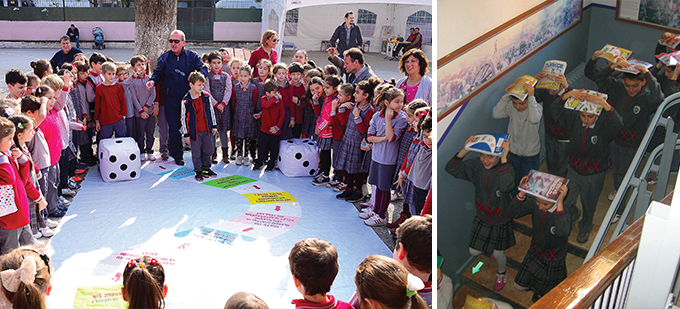Home > Highlighting JAPAN >Highlighting Japan March 2015>Disaster Risk Reduction
Highlighting JAPAN

Disaster Risk Reduction
Rock-Solid Knowledge
Bringing Japan’s earthquake
disaster risk reduction education to Turkey

Like Japan, Turkey is known as one of the most earthquake-prone countries in the world. A 1999 quake in northwest Turkey caused a great deal of damage; approximately 17,000 fell victim to this disaster, and 600,000 people lost their homes and property. Subsequent aftershocks with a magnitude of from 5 to 7 have been recorded several times, and disaster planning is now a vital priority for the Turkish government. Turkey has received support in this initiative from many countries, including Japan, and is rebuilding with an eye to making public facilities and towns more earthquake-resistant.
What the Turkish government took particular note of was not only structural measures such as building stronger infrastructure but also nonstructural measures: in other words, disaster preparedness and awareness education. The government sought to provide this knowledge to all Turkish children during compulsory education and to their teachers, setting the goal of instilling in them accurate understanding and increased awareness. In September 2008, the Turkish Department of Education turned to Japan—a nation with considerable experience with earthquakes that has its own version of disaster preparedness and awareness education—for assistance in creating its curriculum. In response, the Japan International Cooperation Agency (JICA) undertook a three-and-a-half-year project in the country from October 2010 to July 2014.
When asked for details, Norihito Yonebayashi of JICA’s Global Environment Department says: “Our activities were based on three pillars. The first was training for the teachers. We chose about 260 teachers from all over Turkey, who studied the information necessary to provide disaster preparedness and awareness education and disaster management in schools. Our goal was for them to pass the knowledge they gained on to their colleagues where they work, and thereby gradually increase the number of teachers and staff across the country with these skills.
“The second pillar was creating coaching handbooks for the teachers and making suggestions on how to incorporate disaster preparedness and awareness education into their teaching materials and lesson plans,” he continued. “For the classroom, we proposed a curriculum where the education was worked into a variety of subjects, such as life environment studies, social studies, science and so on. This way, the children can gain appropriate knowledge in the course of their daily studies, without setting aside time separately for the subject. The third pillar was disaster prevention management in schools. We helped prepare a guidebook and an effective school disaster preparedness plan, held evacuation drills, hosted disaster prevention events, and created a framework for cooperation between schools and the students’ parents and guardians, as well as local government.”
Those activities were all basically taken as- is from Japan’s disaster awareness education curriculum. An expert team was dispatched to Turkey composed of local government personnel from Hyogo Prefecture—which had been hit by the Great Hanshin-Awaji Earthquake—as well as members of NGOs and other disaster risk reduction and education specialists. For example, common knowledge about disaster risk reduction that was passed on through the Japanese education system, such as protecting oneself and staying underneath one’s desk rather than immediately running outside after an earthquake, and having a bag of emergency provisions on hand, are not common in most countries. Based on Japan’s experience and through basic knowledge of disaster risk reduction, the expert team conveyed the importance of saving lives by taking appropriate measures after an earthquake occurred. The disaster preparedness and awareness caravan for children run by NGOs from Kobe City also received good reviews.
“Through quizzes and games we feel the children deepened their knowledge of disaster preparedness while having fun,” says Yonebayashi. “The former governor of the Turkish province of Bursa also toured the Disaster Reduction and Human Renovation Institution built in Kobe after the Great Hanshin-Awaji Earthquake, and was deeply impressed by the content of its exhibits. He built a similar institution with the province’s budget after returning to Turkey. It’s a place where the risk of earthquakes—and at the same time the importance of disaster preparedness—is communicated to the next generation, so it’s crucial.”
The project has also enabled Turkey’s Department of Education to build an organization to promote such education across departments—a big success, Yonebayashi says proudly. The number of children who have received proper education is growing, and the hope is that they will pass what they’ve learned on to their children.
© 2009 Cabinet Office, Government of Japan






